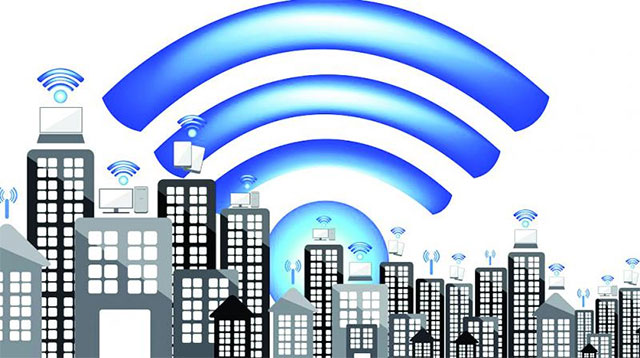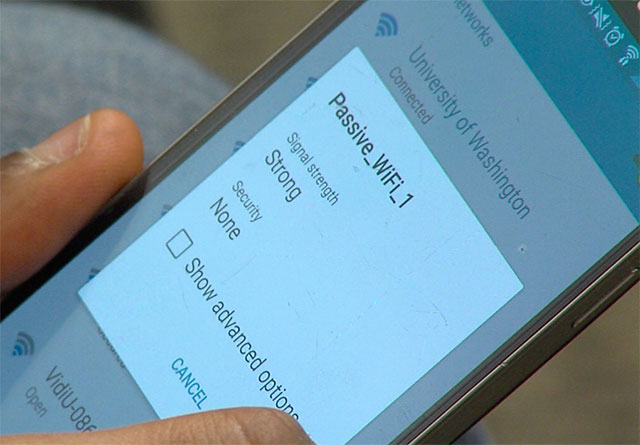Generating electricity from WiFi promises that the future of smartphones without batteries still works well
Yes, the era of batteries on mobile devices may end when scientists have made a major breakthrough, allowing them to convert radio signals into electrical energy.
This discovery can allow not only smartphones but also all mobile devices that can operate normally without batteries, as long as these devices support WiFi reception.In addition, this also brings completely new ways of using technology, in a way that is safer and more environmentally friendly.
This device that converts radio waves into electricity is developed by US scientists, and is named rectenna.Rectenna is the composition of a semiconductor that is only a few atoms thick.

- How can IoT help you enjoy 4.0-style meals?
WiFi signals are collected by integrated antennas, which are then converted into DC current that is suitable for electronic circuits that mobile devices are currently using.
This device is small enough that can be integrated in smartphones, laptops, medical devices and wearable technology to replace traditional batteries, which are unsafe and contaminate the lips. school
Thanks to its versatility, this device can also be built to be used in large areas with poor coverage.And this is the future of the technology world.
Professor Tomas Palacios, director of the Massachusetts Institute of Micro-Technology Technology and Systems Institute, said: "Internet of things devices are becoming indispensable tools in modern life. They appear in everywhere, from the street to the offices, so how can we power these electronic devices in the most effective way? This new invention could be the solution. We have come up with a new way to power future electronic systems - by 'harvesting' power from WiFi in an easy way that can be integrated in the zones. Large area, thereby making better use of the advantages that networking technology has wherever it is. '

In tests, the rectenna can generate about 40 microwatts of electricity when exposed to typical WiFi signals, which fall into about 150 microwatts.And this energy level is more than enough to 'lighten' the screen on a smartphone or activate mobile silicon chips.
The co-author of the study, Professor Jesus Grajal from the Technical University of Madrid, Spain, said one of the most important applications of this invention could be in the field of implant devices. Medical in the body, as well as the "smart drugs" that are receiving much attention from health professionals in recent times.He added: "The biggest problem preventing the effectiveness of electronic devices that can be implanted in the human body is that they cannot operate for a long time because they cannot use batteries to provide power. It is simply because if the lithium battery leaks in the human body, the patient will have a very high risk of death. '

To create rectenna, the team used a new 2D material called molybdenum disulphide, with a thickness of just 3 atoms, and one of the world's thinnest semiconductors. The antennas will be responsible for producing electricity, but they will also be very small in size.
Electricity obtained from radio waves will be in the form of high-frequency alternating current (AC).After that, the semiconductor will be able to convert the AC signal into direct current that can be easily used in mobile devices.
Scientists are now planning more complex devices with markedly improved efficiencies.If it could be applied in practice, this invention could completely change the technological world, as well as the way we use technology.
See more:
- This may be the future smartphone: No 'holes', no ports, no wires and no buttons
- The most remarkable smartphone models 5G will be released in February, who will lead the game?
- The company has created an SD memory card that can store data on par with the hard drive you are using
- LG's future TV: Can be rolled in a box and will be sold in 2019
You should read it
- How to turn on and turn off Wifi on laptop very fast
- Turn off Bluetooth, turn off WiFi completely on iOS 11
- Instructions on how to play Wifi on Lumia phones
- Instructions for looking up electricity money on the phone
- Should I turn on the WiFi router continuously or not?
- How to connect WiFi for Windows laptops and fix WiFi errors on Windows laptops
- How to turn off WiFi of Raspberry Pi
- How to save electricity bills for your family is simple and effective
May be interested
- Smartphone will replace the car keys in the future
 use smartphones to unlock devices or vehicles that are about to be popular in the near future thanks to technology called digital key.
use smartphones to unlock devices or vehicles that are about to be popular in the near future thanks to technology called digital key. - Top 4 smartphones with 'buffalo' batteries today
 the criteria for buying a smartphone depend not only on the battery capacity but also on the features and life of the phone. however, you probably won't want your phone to run out of power in emergencies. in this article, tipsmake.com will introduce you to the top 4 smartphones with the longest battery life as well as quite good performance.
the criteria for buying a smartphone depend not only on the battery capacity but also on the features and life of the phone. however, you probably won't want your phone to run out of power in emergencies. in this article, tipsmake.com will introduce you to the top 4 smartphones with the longest battery life as well as quite good performance. - How do I know if my laptop battery is bottled or broken?
 although you have kept and maintained laptop batteries very carefully, one day it will still be broken and need to be replaced. but how to know when it is time to replace the battery for the laptop and avoid wasting it when replacing the battery while it still works?
although you have kept and maintained laptop batteries very carefully, one day it will still be broken and need to be replaced. but how to know when it is time to replace the battery for the laptop and avoid wasting it when replacing the battery while it still works? - Future notebook batteries will be made from ... Polymer
 soon, laptop makers will switch to lithium polymer batteries instead of the popular lithium ion technology, sony electrics chairman stan glasgow said.
soon, laptop makers will switch to lithium polymer batteries instead of the popular lithium ion technology, sony electrics chairman stan glasgow said. - Difference between WiFi 5, WiFi 6 and WiFi 6E
 having fast wifi has become indispensable in our daily lives. from surfing the internet and working from home to online gaming and streaming netflix, it all depends on a strong wifi connection.
having fast wifi has become indispensable in our daily lives. from surfing the internet and working from home to online gaming and streaming netflix, it all depends on a strong wifi connection. - It's dangerous to use laptops for a long time, not everyone knows
 in the age of technology, laptops and smartphones are one of those things that don't separate many people. however, if not paying attention to the use process, it is these items that can cause accidents for users.
in the age of technology, laptops and smartphones are one of those things that don't separate many people. however, if not paying attention to the use process, it is these items that can cause accidents for users. - Instructions for looking up electricity money on the phone
 currently, many power companies have allowed customers to look up electricity on their phones with just a few quick steps, so if there is a need to check electricity money online, do not ignore the following content here!
currently, many power companies have allowed customers to look up electricity on their phones with just a few quick steps, so if there is a need to check electricity money online, do not ignore the following content here! - What is WiFi 6E? How is WiFi 6E different from WiFi 6?
 technology is always developing very quickly, when wifi 6 was just popular, the new standard wifi 6e was officially launched. so what is wifi 6e? wifi 6e is nothing different than wifi 6, invite you to find out.
technology is always developing very quickly, when wifi 6 was just popular, the new standard wifi 6e was officially launched. so what is wifi 6e? wifi 6e is nothing different than wifi 6, invite you to find out. - What is Wifi 7? Top 5 Wifi 7 transmitters worth buying today
 wifi 7 technology is gradually popular in life and is a potential future wireless connection network standard. let's find out what wifi 7 is? top 5 wifi 7 transmitters worth buying today in this article.
wifi 7 technology is gradually popular in life and is a potential future wireless connection network standard. let's find out what wifi 7 is? top 5 wifi 7 transmitters worth buying today in this article. - What is WiFi 6? What is WiFi 6E? Things you need to know about WiFi 6 and WiFi 6E
 help you better understand wifi 6 and wifi 6e, the differences of wifi 6e compared to wifi 6 and other devices using wifi 6e. join us to find out in the article below.
help you better understand wifi 6 and wifi 6e, the differences of wifi 6e compared to wifi 6 and other devices using wifi 6e. join us to find out in the article below.










 Chrome 72 officially launched, blocked code injection and many new features for developers
Chrome 72 officially launched, blocked code injection and many new features for developers Samsung will launch a 1TB memory chip for smartphones, will it appear on Galaxy S10?
Samsung will launch a 1TB memory chip for smartphones, will it appear on Galaxy S10? MobiFone is the fastest 4G network in Hanoi, Viettel is at the end
MobiFone is the fastest 4G network in Hanoi, Viettel is at the end Will Samsung launch a foldable gaming phone?
Will Samsung launch a foldable gaming phone? Revealing Apple's latest invention: The keyboard is made of glass and can be bent
Revealing Apple's latest invention: The keyboard is made of glass and can be bent Financial support corner: China currently has an application to help detect when debtors are near
Financial support corner: China currently has an application to help detect when debtors are near